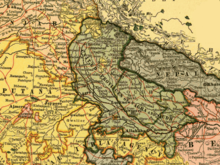
Awadh, known in British historical texts as Avadh or Oudh, is a historical region in northern India, now constituting the northeastern portion of Uttar Pradesh. It is roughly synonymous with the ancient Kosala region of Hindu, Buddhist, and Jain scriptures.

The United Provinces of Agra and Oudh was a province of India under the British Raj, which existed from 22 March 1902 to 1937; the official name was shortened by the Government of India Act 1935 to United Provinces (UP), by which the province had been commonly known, and by which name it was also a province of independent India until 1950.

Begum Hazrat Mahal, also known as the Begum of Awadh, was the second wife of Nawab of Awadh Wajid Ali Shah, and the regent of Awadh in 1857–1858. She is known for the leading role she had in the rebellion against the British East India Company during the Indian Rebellion of 1857.

Barabanki district is one of the five districts of Ayodhya division in the central Awadh region of Uttar Pradesh, India. Barabanki city is the administrative headquarters of Barabanki district. Total area of Barabanki district is 3891.5 Sq. km.
Taluqdars or Talukdar, were aristocrats who formed the ruling class during the Delhi Sultanate, Bengal Sultanate, Mughal Empire and British Raj. They were owners of a vast amount of lands, consistently hereditary, and were responsible for collecting taxes. The Taluqdars played helpful roles in the progression of Indian architecture and Indian economy during the reign of Emperor Shah Jahan and Aurangzeb, particularly in Bengal Subah, the most economically developed province in South Asia.
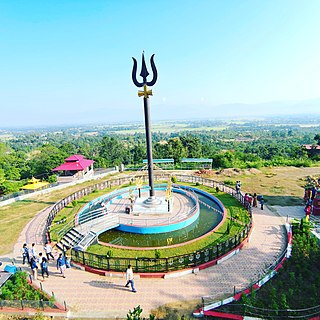
Dang District is a district of Lumbini Province located in the Inner Terai of midwestern Nepal. Deukhuri valley of the district is the capital of the province and is the second largest valley of Asia surrounded by Sivalik Hills and Mahabharata Range. The district headquarter Ghorahi is the seventh largest city and the largest sub-metropolitan city of Nepal. Tulsipur sub-metropolitan city, the second largest city of Dang, is a major transportation hub with extensive road and air networks. The district covers an area of 2,955 km2 and has a population of 548,141.
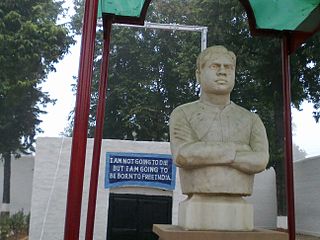
Gonda district is one of the districts of Uttar Pradesh, India. The city of Gonda is the district headquarters, and also the administrative centre for the Devipatan Division. The total area of Gonda district is 4,003 km2 (1,546 sq mi).

Tulsipur is a town and tehsil in the Balrampur district of the Indian state of Uttar Pradesh, A very famous sacred place Devi Patan Temple lies in the city, which is a sacred and pilgrimage site for Hindus, many pilgrims across the country and from Nepal log participation during Maha Shivratri and a fair also held during the festival."
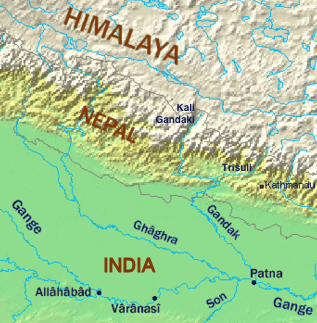
Baise Rajya were sovereign and intermittently allied petty kingdoms on the Indian subcontinent, ruled by Khasas from medieval Nepal, located around the Karnali-Bheri river basin of modern-day Nepal. The Baise were annexed during the unification of Nepal from 1744 to 1810. The gorkha kingdom's founder Prithvi Narayan Shah did not live to see this, but his son and grandson annexed the entire collection by the end of the 18th century.

Ghorahi is the largest sub-metropolitan city by area and population of Lumbini Province. The city lies in Lumbini Province in the Mid-Western part of Nepal. It is the largest city of Dang Deukhuri District of southwest Nepal. Located in the Inner Terai region, it lies 413 kilometres (257 mi) south-west of Nepal's capital Kathmandu and is one of the Counter Magnets being developed as an alternative centre of growth to help ease the migration and population explosion in the Kathmandu metropolitan area. It is the largest city of the Rapti Zone and is surrounded by the Sivalik Hills to the south and Mahabharata Range to the north.
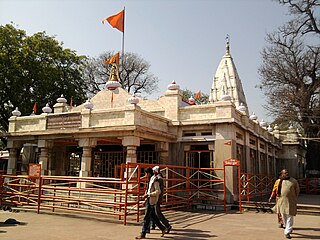
Balrampur district is one of the district of the Indian state of Uttar Pradesh and is a part of Devipatan division as well as the historic Awadh regions. It has been cut from the adjacent district Gonda in 1997. Located on the banks of the West Rapti River. Balrampur is known for the temple of Pateshwari Devi, a Shakti Pitha, and for the ruins of the nearby ancient city of Sravasti, now a pilgrimage site for Buddhists and Jains. The nearest airport is Shravasti airport 23.3 kilometres (14.5 mi) from the town but it is not an international and regular airport; the nearest international and regular airport is Chaudhary Charan Singh International Airport in Lucknow, 235 kilometres (146 mi) away. Lucknow is the capital city of Uttar Pradesh and is 220 kilometres (140 mi) from Balrampur district headquarters.
Tulsipur is a Sub-Metropolitan City in Dang District of Lumbini Province of Nepal. It is the district's second most populous city after Ghorahi. It was established in 1992 by merging the former village development committees (VDCs) Tulsipur and Amritpur. In 2014, it was expanded with the addition of VDCs of Urahari, Tarigaun, Pawannagar and Halwar. At the 2011 Nepal census, it had a population of 141,528 people in 31,243 households.

Birjis Qadr was the son of Wajid Ali Shah, the last Nawab of Awadh. He was a pretender to the throne after his father had been deposed by the East India Company in 1856 under the terms of the Doctrine of lapse and Oudh State was annexed into the Bengal Presidency.
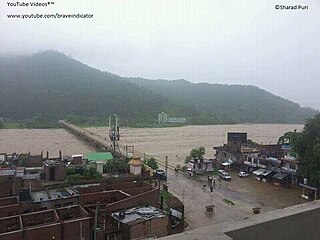
The West Rapti, also known as the Kuwano, is a river which drains Rapti Zone in Mid-Western Region, Nepal, then Awadh and Bhojpur-Purvanchal regions of Uttar Pradesh state, and finally India before joining the Ghaghara. It is a major left bank tributary of the Ganges, and is also known as the Karnali in Nepal.

Lal Pratap Singh was a member of the Bisen Rajput dynasty of Kalakankar. He was prominent leader in the Indian Rebellion of 1857. He was killed during the 1858 Battle of Chanda. The Government of India issued a postage stamp on 17 December 2009 to commemorate him.

The Babai River originates in and completely drains Inner Terai Dang Valley of Mid-Western Nepal. Dang is an oval valley between the Mahabharat Range and Siwalik Hills in its eponymous district. Dang was anciently home to indigenous Tharu people and came to be ruled from India by the House of Tulsipur who also counted as one of the Baise Rajya —a confederation of 22 petty kingdoms in the Karnali (Ghagra) region. About 1760 AD all these kingdoms were annexed by the Shah Dynasty during the unification of Nepal, except Tulsipur lands south of the Siwalik Hills were not taken. Since Dang Valley was somewhat higher, cooler, better-drained and therefore less malarial than most of the country's Inner Terai, it was settled to some extent by Shah and Rana courtiers and other Paharis long before DDT was introduced to control the disease-bearing Anopheles mosquito.

The Oudh State was a Mughal subah, then an independent kingdom, and lastly a princely state in the Awadh region of North India until its annexation by the British in 1856. The name Oudh, now obsolete, was once the anglicized name of the state, also written historically as Oudhe.
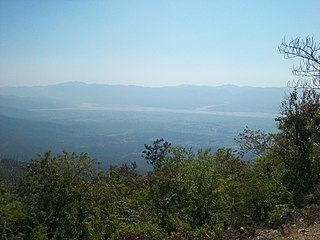
Deukhuri, also known as Deukhuri Valley, is a proposed permanent capital of Lumbini Province in Nepal which was decided on 20th of Aswin 2077 BS. The temporary capital of Lumbini is in Butwal.
Rana Beni Madho or Beni Madho Baksh Singh Bais was one of the most important leaders in the Indian rebellion of 1857 from the Oudh region. He belonged to the Bais clan of Rajputs and was the ruler of the Shankarpur estate in modern-day Rae Bareli, part of the old Baiswara region in Oudh. He led a rebellion against the British forces in 1857. His son was married to the grand daughter of another prominent revolutionary leader Kunwar Singh of Jagdishpur estate.

Kohra was an estate (taluqdari) of Oudh, British India. The taluqdari was controlled by the Bandhalgoti clan of Rajputs. Now it is part of Amethi district in Uttar Pradesh, India.
